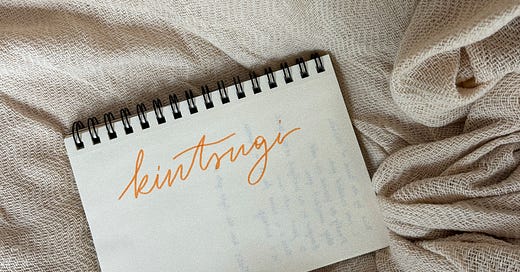This year has probably been the hardest of my life. Don’t get me wrong, there have been plenty of beautiful moments, gifts, love, and fellowship. But there’s also been loss, the weight of war, unfulfilled hopes, sudden death, failures, and dead ends that I fought against with all I had.
Familiar parts of me have been dying, and each day felt like I was piecing myself back together. I lost my sense of direction, and my dreams no longer made sense. I've never felt so unsure of who I was or who I wanted to be. I went from being brave to cautious, then frustrated, and finally, simply lost. I've been reading a lot of wilderness stories, reflecting on death and rebirth, pain, silence, and the loss of hope.
The idea of kintsugi entered my life a few months ago. It started at a house church when I saw a picture of Jesus mending a broken vase with gold; then through Lana Del Rey’s song; and finally, just a few days ago, when I began reading "The Soul of Desire" by Curt Thompson.
“Kintsugi, a venerable Japanese tradition of mending broken pottery with lacquer and powdered gold, is a path toward seeing the fractures and fragments as something to be highlighted (with gold), thereby making the resulting mended object more valuable than the original or as valuable as the original may have been before it was broken.”
Kintsugi has become a source of hope for me—seeing Jesus as the Kintsugi Artist who was himself broken and who now puts pieces back together. Jesus chose to keep his wounds after the resurrection, just as kintsugi highlights, rather than hides, the mended areas. When we seek God’s healing, He is gracious but doesn’t erase our pain. Instead, He uses our broken pieces to create new beauty.
We tend to forget that growth isn't linear and that life is more of a cycle than a stairway. We are tricked into believing that God’s ultimate will is focused on our well-being, good health, stable finances, and happiness. Yet, when Peter urged Jesus to avoid suffering, Jesus responded, “You have no idea how God works” (Matthew 16:23, MSG). For Jesus suffering was part of God’s plan, and so it is for us. Pain reveals our dependency on God’s mercy, shows our weaknesses and brings us back from relying on our own strengths to finding comfort in God’s arms. We learn to rest in the shade of a pillar of cloud that never disappears even though it doesn't seem to be of much help.
I’ve read that the central idea of Christian faith is death and rebirth. Just as Jesus died and rose again in three days, we also die—through trauma, the breaking of our character, and terrible events beyond our control. But we die so that we can be brought back to life—not as our old selves, but as something new, repeatedly, throughout our lives. Wherever there is pain, there is also hope for healing and restoration.
Of course, we don’t just forget what happened, but that’s part of the beauty. Our scars make us more compassionate, equipping us to support others in pain when it’s our turn to do so. God doesn’t heal us for our own sake alone; He heals us so that we can join Him in creating something new. And this is the essence of kintsugi. Re-made, re-purposed, and restored, we can join God in bringing new beauty into a world that desperately needs hope, healing, and rebirth.




